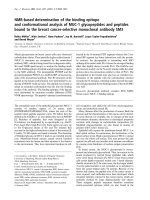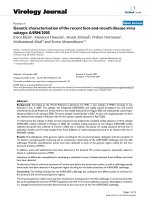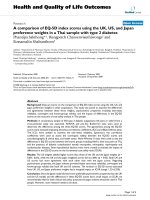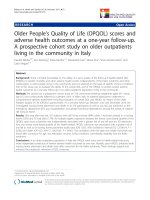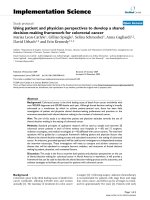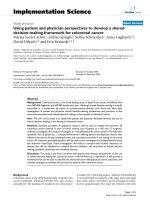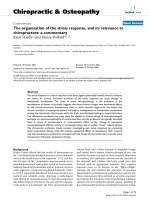The application of the park ride and TOD concepts to develop a new framework that can maximise public transport patronage
Bạn đang xem bản rút gọn của tài liệu. Xem và tải ngay bản đầy đủ của tài liệu tại đây (4.23 MB, 301 trang )
THE APPLICATION OF
THE PARK & RIDE AND TOD
CONCEPTS TO DEVELOP A NEW
FRAMEWORK THAT CAN MAXIMISE
PUBLIC TRANSPORT PATRONAGE
By
Simon Ginn
BSc (Hons); Dip Mkt Man; Dip Town Planning;
MEng Sc(Civil)
School of Civil Engineering
Queensland University of Technology
Australia
A thesis submitted for the degree of Masters of Applied Science
(Research) in the Faculty of Built Environment, Queensland
University of Technology
NOVEMBER 2009
ABSTRACT
With growing concern over the use of the car in our urbanized society, there have emerged a
number of lobby groups and professional bodies promoting a return to public transport,
walking and cycling, with the urban village as the key driving land use, as a means of making
our cities’ transportation systems more sustainable.
This research has aimed at developing a framework applicable to the Australian setting that
can facilitate increased passenger patronage of rail based urban transport systems from
adjacent or associated land uses. The framework specifically tested the application of the
Park & Ride and Transit Oriented Development (TOD) concepts and their applicability
within the cultural, institutional, political and transit operational characteristics of Australian
society. The researcher found that, although the application of the TOD concept had been
limited to small pockets of town houses and mixed use developments around stations, the
development industry and emerging groups within the community are posed to embrace the
concept and bring with it increased rail patronage. The lack of a clear commitment to
infrastructure and supporting land uses is a major barrier to the implementation of TODs.
The research findings demonstrated significant scope for the size of a TOD to expand to a
much greater radius of activity from the public transport interchange, than the commonly
quoted 400 to 600 meters, thus incorporating many more residents and potential patrons.
The provision of Park & Rides, and associated support facilities like Kiss & Rides, have
followed worldwide trends of high patronage demands from the middle and outer car
dependent suburbs of our cities. The data collection and analysis gathered by the researcher
demonstrated that in many cases Park & Rides should form part of a TOD to ensure ease of
access to rail stations by all modes and patron types. The question, however, remains how
best to plan the incorporation of a Park & Ride within a TOD and still maintain those
features that attract and promote TODs as a living entity.
II
TABLE OF CONTENTS
PART A
INTRODUCTION & LITERATURE REVIEW
Chapter 1 – Introduction
1.0
Background
3
1.1
Hypothesis
5
1.2
Aim of Research
5
1.3
Influencing Factors
6
1.4
Specific Objectives of the Research
6
1.5
What does this Research Add as New Knowledge?
7
1.6
Background on the Research Subject
8
1.7
Structure of Thesis
9
Chapter 2 – Methodology
2.0
Introduction
10
2.1
Research Methodologies to Gather New Knowledge
10
LITERATURE REVIEW
Chapter 3 – Land Use & Transport Interactions
3.0
Introduction
18
3.1
Changing Travel Patterns and Impacts
18
3.2
Travel Demand Management Tools
27
3.3
Land Use and Transport Integration
37
3.4
Urban Consolidation and Density
43
Chapter 4 – Transit Oriented Developments
4.0
Definitions of TODs
48
4.1
The Emergence of Transit Oriented Developments (TOD) as a Concept
50
III
4.2
Images of Transit Villages
55
4.3
Contrasting Views on TODs
55
4.4
TOD Examples
56
4.5
General Opportunities & Barriers for Transit Oriented Developments
75
4.6
Experiences and Opportunities with TODs emerging out of North America
76
4.7
Barriers to Implementing TODs in North America
79
4.8
Summary of Barriers and Opportunities for TODs
82
4.9
The Impact on Transit Systems Patronage from Traditional and Neotraditional
Neighbourhood Designs
83
4.10
Joint Ventures around Public Transport Interchanges
84
4.11
Conclusion to Literature Review of TODs
85
Chapter 5 – Park & Rides and Interchange Support Infrastructure
5.0
Supporting Public Transport with Good Interchange Facilities
86
5.1
Definitions of a Park & Ride
86
5.2
The Kiss & Ride Component associated with Park & Rides
87
5.3
Park & Ride Concept, Objectives and Realities
88
5.4
Successes and Failures with Park & Rides
96
5.5
Types of Park & Rides
96
5.6
Literature Review of park & Ride Case Studies
97
5.7
Conclusions to Literature Review on Park & Rides
101
5.8
Station Design
102
5.9
Conclusion to Park & Rides and Interchange Support Infrastructure
103
IV
Chapter 6 – Transit Patronage
6.0
Introduction
104
6.1
Capacity of Transit Systems and Patronage Levels
104
6.2
Accessibility and Patronage
106
6.3
Access to Stations and Patronage Levels by Distance
107
6.4
Future Patronage Forecasts on Public Transport Systems
111
6.5
Demand Forecasting Patronage
112
6.6
Conclusions on Transit Patronage Demands
114
Chapter 7 – The Influence of Property Values and Growth near Transit Stations as a
Derivative of Patronage Demands
7.0
Introduction
7.1
The Influence of Property Values near Transit Stations
7.2
115
and the Derived Patronage Demands
115
Conclusions
118
Chapter 8 – Summary of Literature Review and Implications for Hypothesis &
Framework Development
8.0
Summary of Literature Review
119
8.1
Hypothesis against Literature Review
121
8.2
Key Gaps in Literature Review for Examination
8.3
and Incorporation into an Integrated Framework
121
The Influence of Emerging Technologies on the Hypothesis and Research
122
V
PART B FRAMEWORK DEVELOPMENT
Chapter 9 – Establishing a Conceptualized Setting for a New Integrated Planning
Framework to Promote Patronage Levels
9.0
Introduction
127
9.1
Evidence derived from Decisions with Key Experts and Opinion Leaders
128
9.2
Conclusions
134
9.3
Implications of Results for Hypothesis, Specific Research
Objectives and the Framework Development
135
Chapter 10 – Institutional, Planning and Attitudinal Issues Affecting TODs Patronage
Levels
10.0
Introduction
137
10.1
Ability to Commit to a TOD style of Development and Living
as a Prerequisite to Promoting Patronage
137
10.2
Australian TOD Case Studies
144
10.3
World Wide TOD Case Studies
152
10.4
Conclusions
155
10.5
Implications of Results for Hypothesis, Specific Research Objectives
and Model Development
156
Chapter 11 – Institutional, Planning and Attitudinal Issues Affecting Park & Rides
Patronage Levels
11.0
Introduction
158
11.1
Commitment to Park & Rides
158
11.2
Demand for Access to Park & Rides
159
11.3
World Wide Park & Ride Case Studies
167
11.4
Mixing Park & Rides and TODs to Promote Patronage
170
11.5
Combining TODs and Park & Rides and Associated Infrastructure to
Increase Patronage Demands
171
11.6
Conclusion
172
11.7
Implications of Results for Hypothesis, Specific Research Objectives and
VI
the Framework Development
173
Chapter 12 – How Distance Impacts on Access to Transit – Affecting Patronage Levels
from TODs and Park & Rides
12.0
Introduction
174
12.1
Empirical Data on the Inter-Relationships between Distance, Mode and Land
Use on Arrival Numbers of patrons at Fixed Guideway Stations
12.2
175
Should TODs and Park & Rides be Mixed Around the same Station /Public
Transport Interchange Site?
192
12.3
Conclusions
193
12.4
Implications of Results for Hypothesis, Specific Research Objectives and
the Framework Development
193
Chapter 13 – Transit Operational and Station Design Factors Affecting Patronage
Levels from TODs and Park & Rides
13.0
Introduction
195
13.1
How Transit and Station Design Factors Affect Patronage Levels
196
13.2
Conclusions
202
13.3
Implications of Results for Hypothesis, Specific Research Objectives and
the Framework Development
203
Chapter 14 – The Framework
14.0
Introduction
204
14.1
The Key Guiding Principles for TODs to Promote Patronage in Australia
205
14.2
The Key Principles for Park & Rides to Promote Patronage
209
Part C THE MODEL APPLICATIONS & CONCLUSIONS
Chapter 15 – Testing the Framework in a Real Application and the Framework’s
Limitations
15.0
Introduction
213
VII
15.1
Potential Application of the Framework to a Test Case Situation within the
Australian Setting
213
15.2
Limitations of the Framework
219
15.3
Conclusions
220
Chapter 16 – Transferability & Future Framework Applications
16.0
Introduction
221
16.1
Transferability
221
16.2
Demonstration of the Framework within a 3D Virtual Reality Environment over a
Hypothetical Location in Australia and its Application to China
221
16.3
The model as a Research and Teaching Tool
223
16.4
Conclusions
223
Chapter 17 – Conclusions
17.0
Introduction
224
17.1
The Hypothesis under Examination
224
17.2
Summation
230
REFERENCES
234
VIII
APPENDICES
Appendix 1
Practioners Interviewed on Land Use and Transport
Integration around Rail Stations
252
Appendix 2
World Opinion Leaders (Experts) Surveyed by Email
254
Appendix 3
Questions for World Opinion Leaders by Email
257
Appendix 4
Questions for Meetings with Councils, Developers and Operators
259
Appendix 5
Initial Telephone Survey of Households to Engage in
Main Household Survey
260
Appendix 6
Demographic Questions of Households in Main Household Survey
261
Appendix 7
Survey of Scale of Life Style Preferences in Main Household Survey
263
Appendix 8
Main Household Survey Using Questions and Images
264
Appendix 9
Perth Station’s Patronage by Origin, Data Collection Form
281
Appendix 10 Surveyor’s by Perth Station, Date and Start Time
282
Appendix 11 Photo of Test Site for Application of Model to Fitzgibbon
284
IX
LIST OF FIGURES
Figure 1:
Travel Demand Management Classifications
Figure 2:
Suggested Mix of Housing Types in a Development to Promote
31
Public Transport Usage
44
Figure 3:
Population Densities in 1980 per Person per Hectare
46
Figure 4:
Total Demand Requirements by Access Mode - Helensvale
89
Figure 5:
Capacity Ranges of Different Modes
104
Figure 6:
Patronage Levels in Europe and North America
105
Figure 7:
Operating Cost Recovery
106
Figure 8:
LRT Population and Employment Catchment
110
Figure 9:
Support for Transit Oriented Sustainable Developments by Gender
140
Figure 10:
Support for Transit Oriented Sustainable
Developments by Age Group
Figure 11:
141
Support for Transit Oriented Sustainable
Developments by Cars per Household
Figure 12:
141
Support for Transit Oriented Sustainable
Developments by Respondent Suburb
142
Figure 13:
Key Advantages of a TOD
143
Figure 14:
Key Desirable Features within a TOD
144
Figure 15:
Preference to Drive to Station Park & Rides,
then take Train to Work
Figure 16:
160
Preference to Drive to Station Kiss & Ride,
then take Train to Work
160
Figure 17:
Preference to Provide Park & Rides at Rail Stations
161
Figure 18:
Support the Provision of Park & Rides and
Kiss & Rides at Rail Stations
162
Figure 19:
Park & Rides are Conveniently Located
163
Figure 20:
Free Parking Important at Park & Rides
163
Figure 21:
No of Parking Bays Available Important at Park & Rides
164
X
Figure 22:
Park & Rides Provide the Ability to Live Further away
from a Rail Station
165
Figure 23:
Electronic Information on Freeways to Attract Patrons to Park & Rides
166
Figure 24:
Desirable Features to Using a Park & Ride
167
Figure 25:
Park & Rides Should be Incorporated within a TOD
172
Figure 26:
Currambine Station Arrivals by Mode
178
Figure 27:
Joondalup Station Arrivals by Mode
179
Figure 28:
Warwick Station Arrivals by Mode
181
Figure 29:
Fremantle Station Arrivals by Mode
184
Figure 30:
Midland Station Arrivals by Mode
185
Figure 31:
Distance Traveled to Each Station by Walking Patrons
186
Figure 32:
Mode Walk by Distances
187
Figure 33:
Distance Traveled to Each Station by Patrons when Parking & Riding
188
Figure 34:
Mode Park & Ride by Distances
189
Figure 35:
Distance Traveled by Patrons to Each Station when Kiss & Riding
190
Figure 36:
Mode Kiss & Ride by Distances
191
Figure 37:
Level of Train Service & Frequency Important at Park & Rides
197
Figure 38:
Feel Safe and Secure when Traveling
198
Figure 39:
Security is an Issue Affecting Use of Railway Stations
199
Figure 40:
Security Alarms at Rail Stations Promote Security
200
Figure 41:
Rail Station Lighting Promotes Security
200
Figure 42:
Security Important at Park & Rides
201
Figure 43:
Security Important at Park & Rides by Suburb
202
XI
LIST OF ILLUSTRATIONS
Illustration 1:
The Thesis Structure
1
Illustration 2:
The Thesis Structure
9
Illustration 3:
The TOD Concept Illustrated in Broad Principle
49
Illustration 4:
The Framework within the Thesis Structure
126
Illustration 5:
The Key TOD Principles& Supporting Factors
to Promote Patronage
Illustration 6:
207
The Key Park & Ride Principles & Supporting
Factors to Promote Patronage
Illustration 7:
211
The Framework Application within the Thesis
Structure
212
XII
LIST OF MAPS
Map 1:
Perth Stations
176
Map 2:
Warwick Railway Station Park & Ride Catchment
180
Map 3:
Fremantle Railway Station Walkers Catchment
183
Map 4:
Brisbane Suburban Rail Network
214
XIII
STATEMENT OF ORIGINAL
AUTHORSHIP
The work contained in this thesis has not been previously submitted for a degree or diploma
at any tertiary educational institution. To the best of my knowledge and belief, the thesis
contains no material previously published or written by another person except where due
reference is made.
Signed:
Date:
XIV
PUBLICATIONS ARISING FROM
THIS THESIS
Reports and Journals
Ker I. and Ginn S. (2003) Myths and Realities in Walkable Catchments: The Case of
Walking and Transit, Road and Transport Research. Vol 12 No 2, June 2003.
Gilbert D. and Ginn S. (2001) Transit Oriented Sustainable Developments, Built
Environment Research Unit, Queensland Department of Public Works, August 2001
Ginn S. (1998) An Evaluation of the Options for Light Rail within the Australian
Urban Environment, a report presented to and published by the Western Australian
Planning Commission, August 1998.
Conferences
Bucolo S. and Ginn S. (2004) Using Virtual Reality Models to Better Communicate How
Decisions are made to Build Future Cities paper jointly presented at the Planning on the
Edge- National Planning Institute of Australia Conference, Hobart, Australia, February 2004
Ginn S. (2003) Determining Future Patronage Demands in New Urban Growth
Corridors and the Implications for TOD and Park & Rides, paper presented at the RailVolution Conference, Atlanta, USA, September 2003
Bucolo S. and Ginn S. (2003) Using Virtual Reality Models to Better Communicate How
Transit Infrastructure can Interface and Interact with the Built Environment paper
jointly present at 21st ARRB Transport Research Conference in Cairns, Australia, May 2003
XV
Ginn S. and Kerr I. (2003) Myths and Realities in Walkable Catchments: The Case of
Walking and Transit paper jointly present at 21st ARRB Transport Research Conference in
Cairns, Australia, May 2003
Ginn S. (1998) Transit Oriented Developments or Park & Ride: Which Land Use will
Promote a More Efficient Demand for Public Transport?, Royal Australian Planning
Institute Conference, Brisbane, July 1998
XVI
ACKNOWLEDGEMENTS
I would like to thank my wife, Christine Ginn and family, for their continual support in the
time and effort required in researching, staying focused and preparing this thesis.
A special thanks goes to my principal supervisor, Luis Ferreira, for his continual support and
guidance to help moderate and direct my efforts towards developing a worthy piece of new
knowledge. I would also like to thank my associate supervisor, Phil Heywood, for his very
enduring enthusiasm and support to take the subject matter to a higher dimension.
The collection of the research findings presented is this thesis were supported by the Western
Australian Department of Transport, the Queensland Department of Public Works and the
Queensland University of Technology.
In addition, I would like to express by deepest gratitude and thanks to the family of the late
Peter Pritchard without whom the use of cartoon images to present concepts of various urban
forms around railway station would have been almost impossible to present.
XVII
PART A
INTRODUCTION & LITERATURE REVIEW
Part A is the introduction and literature review to this Masters of Applied Science research
thesis. The first section covers chapter 1 on the following introductory topics:
•
Background
•
Hypothesis
•
Aim of Research
•
Influencing Factors
•
Specific Objectives of the Research
•
What does this Research add as New Knowledge?
•
Background on Research Subject
•
Structure of the Thesis
Chapter 2 covers the research methodologies applied to gather new knowledge.
Illustration: 1
The Thesis Structure
Introduction
Part A
Chapter 1 & 2
Literature Review
Chapters 3 - 7
Original Data
Intro to Framework
Part C
New Knowledge
Part B
Chapter 9
Institutional
& Planning
Chapters 10 & 11
Conceptualization
with Experts
Access to
Transit
Operational
Factors
Chapters 12
Chapter 13
Public Attitudes
Developer &
Council Attitudes
Key Opinion leaders
The Framework Chapter 14
Station Access
Survey
Testing & Limitations
Chapter 15
Transferability & Development
Chapter 16
Conclusions
1
Australian Case
Studies
Rail Volution
The second section covers the main literature review chapters on:
•
Land Use and Transport Interactions (Chapter 3)
•
Transit Oriented Developments (Chapter 4)
•
Park & Rides and Interchange Support Infrastructure (Chapter 5)
•
Transit Patronage (Chapter 6)
•
Influence of Property Values near Transit Stations as a Derivative of Patronage Demands
(Chapter 7)
•
Summary of Literature Review Implications for Hypothesis and Framework
Development (Chapter 8)
2
Chapter 1 – Introduction
1.0
Background
Since the Second World War, humanity’s desire to urbanize increasing proportions of the globe
has continued to increase. The trend towards very large collectives of people living in close
proximity to many others has brought with it numerous benefits; but it also brings increasing
limitations that are slowly, and in some cases alarmingly, coming to the forefront with much
domestic and international debate.
Central too much of this debate is the need for sustainable cities and communities that better
manage the use of all natural, non-renewable resources. Urban sustainability is the supply of
amenities such as water and sewerage, food, transportation, health and housing, in a way that
minimizes the use of all non-renewable resources to improve the existing and future living
standards of all urban dwellers. The aim of sustainability is complicated by the fact that any
improvements to make one element more sustainable can, if not carefully managed, impact on
the capacity for other elements to achieve sustainability. A holistic approach to urban
sustainability within our cities and communities is the ideal goal.
This research will investigate how to better meet the need for sustainable transport within our
cities as a function of urban planning, through seeking to formulate a framework that can
promote increased use of rail based or fixed guideway public transport systems. The need to
achieve a more sustainable focus on urban transport has been largely driven by the continued
growth of our cities since the Second World War. The expansion of the population into the
middle and outer suburbs has been facilitated by cheap and ready access to the private car and
the desire to own a large home within easy commuting distance of most cities. In the 1950’s and
1960’s, most government agencies happily promoted the development of these new suburban
communities, connected by large freeways to the cities, as the answer to the baby boom demand
for family housing. In the last twenty to thirty years, increasing concern has been expressed on a
local, national and international level at the rate of car growth in our cities, and the consequences
3
of this growth in terms of congestion, air pollution and the contribution of car emissions towards
greenhouse gases and global warming.
With growing concern over the use of the car in our urbanized society, a number of lobby groups
and professional bodies are promoting a return to public transport, walking, cycling and urban
villages as a means of making our cities’ transportation systems sustainable. It has been
recognized that the way urban planners and society design and manage urban development can
make a significant contribution towards reducing the magnitude of car based trips. A trip is
simply the need to connect people or goods with one urban form and another. If these urban
forms could be brought closer together or made less dependent on road vehicle trips via public
transport, cycling or walking, less vehicle trips would occur. Whilst recognition exists that there
is a link between reducing car based urban trips and the way we plan our urban development,
limited research and development has followed to develop models capable of delivering better
outcomes with institutional support.
This research is aimed at developing a framework that can facilitate the increased passenger
patronage of rail based urban transport systems from adjacent or associated land uses. It
addresses whether the existing models and frameworks of transit oriented urban developments
commonly applied in North America and Europe, and the existing world wide examples of park
and ride station facilities, can be applied together or separately in Australia to promote rail based
public transport and reduce car dependency in our urban cities.
The culmination of these research interests, supported by current literature and communications
with key world experts, draws the focus of this research towards developing an understanding of
the issues surrounding the introduction of transit oriented developments around rail stations in
Australia. This research will investigate the scope for a framework to accommodate both a
Transit Oriented Development (TOD) and a Park & Ride, or a combination of both
configurations, and their suitability and adaptability within the Australian urban, operational and
institutional setting.
4
Whilst this work concentrates on the interactions between transport and land use planning with
the aim of maximizing public transport patronage, the long term goal is to develop a model
concept for planning sustainable transit oriented developments that can incorporate communities
that are not only transport efficient, but also aim to minimize pollutants and to maximize energy
efficiency in water, waste, building design and telecommunications.
1.1
Hypothesis
Testing the application of the Park & Ride and TOD concepts within the Australian setting,
allows for the development of a new integrated planning framework that can maximize public
transport patronage. This new framework examines the best configurations of land uses in
association with public transport interchanges to promote public use of fixed guideway systems.
1.2
Aim of Research
The primary aim of the research is to formulate and test a new Australian integrated planning
framework, looking at the relationships between different forms of fixed guideway systems and
changing land use patterns, which can maximize modal shifts towards public transport. This new
integrated planning framework of urban forms will focus upon a public transport interchange that
can maximize patronage demand, rather than let the existing or proposed strategic urban forms
derive the demand. The framework will specifically evaluate Transit Oriented Developments and
Park & Ride facilities around public transport interchanges as a means of increasing public
transport patronage.
The research aims to answer the question: what are the appropriate transport and land use
interactions, within an Australian context, that can facilitate improved patronage onto heavy rail
or light rail transit?
It is not the intent of this research to evaluate busways, due to the greater variability in the
operation of bus systems, which brings a lack of public and developer certainty as to its reliable
delivery.
5
1.3
Influencing Factors
The design and form of land uses in and around the receiving public transport interchange may
vary patronage demand, as will the quality of the transit system itself. Operational qualities of
the transit system in terms of rolling stock, frequency of service, route network, pricing and
marketing factors, have a significant impact upon the degree to which the traveling public
embraces public transport, no matter what the proposed land use configurations. Economic,
social, environmental, administrative and institutional arrangements all impact upon patronage
outcomes through their influences on land use patterns and their take up, and on the quality of
transit systems. The potential opportunities and constraints presented by non-fixed guideway and
major road based systems will also need to be investigated as controlling factors.
1.4
Specific Objectives of the Research
The research will increase the understanding of:
1. The transport and land use inter-relationships present in developing mixed use
residential land uses adjacent to public transport interchanges, which can promote
the use of public transport systems for trips between centres and encourage the use
of walking and cycling for more local trips;
2. The inter-relationships between land uses and trip ends and modes available to the
user, that may or may not promote access to Park & Ride facilities and associated
transit services from lower density urban land uses, for part of a trip;
3. What is a reasonable walking and Park & Ride catchment for a rail station to
maximize patronage?
4. Developers’, councils’ and consumers’ attitudes to promoting and accessing
different transit supportive land uses (including barriers and opportunities);
5. The form and elements of a Transit Oriented Development (TOD) to promote
patronage;
6
6. The form and elements of a Park & Ride facility to promote patronage; and
7. The potential scope for combining both a TOD and Park & Ride facility to
maximize patronage from both local and more distant land uses.
To develop such an integrated planning framework and test its application, it will be necessary to
undertake detailed research into past case studies, as well as to collect new data from all the
major interested players and draw on surveys of key worldwide opinion leaders.
The third specific research objective is the central and key research objective to proving
the hypothesis to maximizing public transport patronage.
1.5
What does this research add as new knowledge?
The new integrated planning framework will offer a better understanding of the parameters
required to plan for residential land uses around public transport interchanges, within the
Australian setting, that may facilitate maximum patronage demands on fixed guideway rail or
busway transit systems.
The use of Park & Rides and TODs to integrate residential land uses with a transit mode and help
maximize transit demands, has been the subject of as much myth-making as robust research to
justify a solid policy or modelling background. For example, in suburban areas, 400-metre and
600-metre ‘ped sheds’ have been incorporated in many planning documents as a basis for
enhancing the ‘liveability’ and sustainability of proposed residential developments. These
distances roughly equate to 5 and 10 minute walking times. In the case of fixed guideway transit
systems, a 600-metre catchment is commonly applied to rail stations; however in practice, people
are willing to walk significantly further than this to a rail station which provides a good, regular
service.
The research will evaluate developer and general public attitudes and willingness to encompass
new urban land uses like TODs.
7
Whether that land use configuration is as a TOD and/or Park & Ride will be based on case
studies and surveys, and then developed as a conceptual integrated framework that could be
applied within the Australian urban setting. A greater understanding of the potential catchment
area that a TOD and/or Park & Ride may take to maximise patronage demands. In the case of
this latter factor, the actual size and form of a TOD may differ, based on observed patronage
catchments, from the currently suggested 400 - 600metre radius around a rail station, to
accommodate greater walking distances. Finally, whereas Park & Rides are well established in
the Australian urban setting, this is not the case with TODs. This work will identify the factors
needed to facilitate TODs in Australia by over coming barriers and seeking opportunities to
maximise patronage demands.
1.6
Background on Research Subject
Mitchell and Rapkin’s 1954 publication, ‘Urban Traffic – A Function of Land Use’, pioneered
the integration of land use and transport planning. Since this report, a new breed of professional
has emerged, the transportation planner. Transportation planners are interested in the interaction
between travel demand and the type and location of activities, as a factor in land use. The form
and extent of travel demand is determined not only by the kinds of land uses, but also by the
varying densities at which these lands are used. Land use can be influenced by the level of
accessibility and quality of the transportation system.
In the last decade, there has been renewed interest in seeking better ways to integrate land use
and transport around public transport systems to reduce car dependency and promote public
transport. In Australia, the concept of the ‘Urban Village’ of intensive land uses configured
around public transport interchanges has been strongly promoted by Newman and Kenworthy
(1992), building on the ideas of Peter Calthorpe’s ‘Transit Oriented Developments.’ Some
authors (Cairns, 1997; Roberts et al., 1996) still advocate more extensive use of Park & Ride
style interchange configurations. Within the Australian urban setting of lower density housing
and dispersed employment nodes, access to a car is still a major requirement for mobility. This
further aids urban sprawl and promotes vehicle travel. Increasing environmental concerns are
being expressed about the car’s influence on local air quality and global greenhouse gas
warming. Urban consolidation is starting to occur in the inner cities; yet the outer suburbs
8

